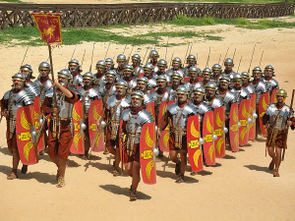Ancient Roman Soldiers Life: The catapult, first invented by Philip II of Greece, was also used by the Roman army. The catapult was fired by winding down a huge beam, which had a sling at one end. A man called a loader lifted a large round stone and fit it into the sling. Stones weighing as much as 66 pounds were flung into the air. They landed up to 100 feet away and could easily make holes in the walls of the enemy’s fort.

During the time of the kings, the Roman army was developed by each tribe providing 1000 infantry and 100 cavalries. During the Republic, the army was called up during times of trouble. Later, a permanent army was developed.
Career of Poor Romans
For many poor Romans, a career in the army was inviting. They were required to be at least eighteen years old and at least five and a half feet tall.

Often it was helpful to get a letter of recommendation to increase the chances of being chosen. A legionnaire could earn about three hundred denarii a year. Some of the money was kept by the army for food, pensions, and equipment.
Ancient Roman Soldiers Life
A soldier could serve for twenty-five years and then retire with a pension. While in the army, the soldier was not allowed to marry, but many had girlfriends in settlements near their fort or base camp.

This rule was however lifted in A.D. 197 and soldiers were allowed to marry. Non-Roman citizens could serve in the army as auxiliary soldiers and receive Roman citizenship and a pension or a piece of land after a twenty-five-year tour.
Roman Soldiers Facts
The army was spilled into large groups known as legions. During the time of Hadrian, about thirty legions were stationed around the empire to protect the borders. The legions were not allowed into Rome itself, except during parades celebrating a great victory. Only the personal guards of the emperor, known as the Praetorian Guard, were allowed in the city limits.

The army served not only as the protector of the empire but was also the organization which built much of the large road system in the empire. Each legion had among its ranks trained stonemasons to help build roads and fort walls.
The roads allowed the army to quickly shift men to problem areas. The army could average twenty-one miles a day on the roads. These road systems also provided a good system for transporting goods throughout the empire.
More info on- Soldier uniform, Army weapons



